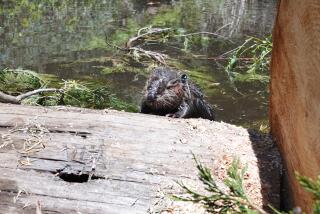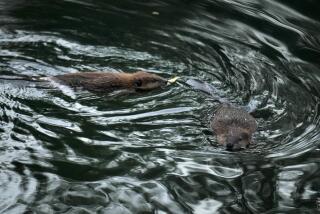Furry Remains Shake Up Jurassic Thinking
- Share via
The discovery of the remains of a furry, beaver-like animal that lived at the time of dinosaurs has overturned more than a century of scientific thinking about Jurassic mammals.
The find shows that the role of mammals in the time of dinosaurs was greater than previously thought, said Zhe-Xi Luo, curator of vertebrate paleontology at Carnegie Museum of Natural History in Pittsburgh.
The animal is the earliest swimming mammal to have been found and was the most primitive mammal to be preserved with fur, which is important to helping keep a constant body temperature, Luo said.
For a century, the stereotype of mammals living in that era has been of tiny, shrew-like creatures scurrying about in the underbrush trying to avoid the giant creatures that dominated the planet, Luo said.
Now, a research team that included Luo has found that 164 million years ago, a mammal with a flat, scaly tail like a beaver, vertebrae like an otter and teeth like a seal was swimming in lakes and eating fish, according to their report in the current issue of the journal Science.
The team, led by Qiang Ji of the Chinese Academy of Geological Sciences in Beijing, discovered the remains in the Inner Mongolia region of China.
Thomas Martin of the Senckenberg Research Institute in Frankfurt, Germany, said the discovery pushed back the mammal conquest of the waters by about 100 million years.
It’s the first evidence that some ancient mammals were semiaquatic, indicating a greater diversification than previously thought, the researchers said.
Modern semiaquatic mammals such as beavers and otters and aquatic mammals like whales did not appear until between 55 million years ago and 25 million years ago, they said.
The new animal is not related to modern beavers or otters but has features similar to them. Thus the researchers named it Castorocauda lutrasimilis: castoro from the Latin for beaver, cauda for tail, lutra for river otter and similis meaning similar.
Weighing 1.1 to 1.7 pounds, about the size of a small female platypus, Castorocauda is also the largest-known Jurassic early mammal.
More to Read
Sign up for Essential California
The most important California stories and recommendations in your inbox every morning.
You may occasionally receive promotional content from the Los Angeles Times.










